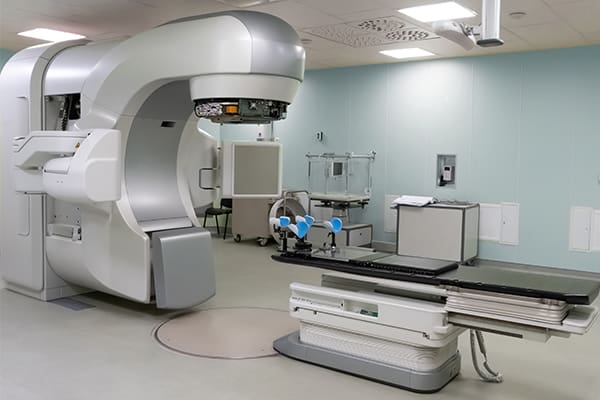01. IMRT Overview
What Is IMRT?
Intensity-modulated radiation therapy (IMRT) is an advanced type of external beam radiation therapy (EBRT). EBRT is the most common type of radiation treatment used to fight cancer, including pleural mesothelioma. IMRT is often part of a multimodal treatment plan that includes other therapies like surgery.
IMRT uses a machine called a linear accelerator (LINAC) to send targeted beams of radiation into a patient’s body to damage and kill cancer cells.
Types of IMRT
Helical tomotherapy and Volumetric-Modulated Arc Therapy (VMAT) are the two primary subtypes of IMRT, which can address different needs.
- Helical tomotherapy: In this variation of IMRT, a large cylinder sends radiation beams into targeted tissue at regular intervals. The beams spiral around the patient, ensuring the radiation reaches all angles. This may be a better option for more complex or large tumors.
- VMAT: This newer variation of IMRT uses continuous radiation beams. Unlike traditional IMRT, the radiation machine does not need to be repositioned. Generally, this allows for shorter treatment sessions. It may also cut down on the amount of radiation patients need to be exposed to.
02. IMRT for Mesothelioma
How Does IMRT Treat Mesothelioma?
IMRT uses high-energy X-ray beams generated by the LINAC machine to target cancerous cells and tumors in the body. It uses beams of different strengths to target malignant cells while minimizing damage to healthy tissues. IMRT may more precisely target cancer cells than traditional radiation. This may make it a good option for treating tumors close to delicate structures, like the spinal cord.
IMRT may be combined with other forms of therapy in a multimodal treatment plan for malignant pleural mesothelioma patients. IMRT is unlikely to be used to treat other types of mesothelioma, like peritoneal. Radiation therapy in general has not proven effective for non-pleural mesothelioma types.
IMRT Procedure
The IMRT procedure has three basic phases: preparation, treatment and recovery. The total process may take weeks or months.
- Preparation stage: Before the IMRT procedure, patients typically undergo imaging tests to plan the radiation sessions. The tests often involve a CT scan of the tumor area. Technicians then use image scans to conduct a treatment simulation session, or “sim.” The sim helps determine the patient’s positioning during treatment. Technicians may place dots on the body to help align the LINAC machine during treatment.
- Treatment stage: IMRT sessions typically last about 30 minutes. Sessions may be spread out over several days or weeks. The radiation technician administers the treatment from a separate room using the LINAC and observes the patient via video. The number of radiation treatments needed depends on patient factors like the severity and type of cancer.
- Recovery stage: Patients can often go home right after radiation treatments. Recovery time depends on multiple factors, including the total dose of radiation received, the number of sessions and the body part treated. Patients should discuss any side effects they experience from IMRT with their care teams.
IMRT Clinical Trials
Some ongoing clinical trials focus on better understanding how IMRT may help treat pleural mesothelioma. One study aims to determine if IMRT, combined with surgery and chemotherapy, causes more or fewer side effects than traditional radiation treatment. Another study involves treatment with the immunotherapy drug Keytruda® and IMRT.
Researchers hope to learn how much radiation is safe for patients with inoperable pleural mesothelioma. Mesothelioma specialists can explain the potential risks and benefits of clinical trials. Interested patients should discuss trial options with their oncology teams.
Resources for Mesothelioma Patients
03. Benefits & Disadvantages
What Are the Benefits and Disadvantages of IMRT?
Like most treatments, IMRT has both advantages and disadvantages. Most of the information researchers have comes from using IMRT to treat other types of cancer. The benefits of IMRT, which may also apply to mesothelioma patients, include:
- Less damage to healthy tissues: IMRT may cause less damage to nearby healthy tissues, resulting in fewer or less severe side effects for patients. It may also be a better option for treating tumors near important organs, like the brain.
- More effective dosing: IMRT can deliver higher, more effective doses of radiation to tumors than traditional radiation.
- Reduced treatment toxicity: IMRT may reduce treatment toxicity compared to the same dose of radiation administered with standard procedures.
There may be some disadvantages to undergoing IMRT therapy, too. Some downsides to IMRT treatment include:
- More time-consuming: IMRT treatments may take more time to plan out than traditional radiation. It also requires consistent, regular sessions with a dedicated team of healthcare providers.
- Side effects: IMRT treatments still have a risk of unpleasant and potentially serious side effects. Examples include appetite loss, fatigue and headaches. Doctors may be able to help ease some side effects.
Doctors can help determine what types of treatment may be the most beneficial for individual patients.
IMRT and Mesothelioma Survival
In studies, pleural mesothelioma patients treated with IMRT had median survivals ranging from about 18 to 43 months. The study patients underwent IMRT as part of a multimodal treatment plan. The average life expectancy for pleural mesothelioma is about 18 months. Clinical trials continue studying how IMRT may affect mesothelioma survival.
04. Side Effects
What Are the Side Effects of IMRT?
Like all types of radiation treatment, IMRT may have side effects. Some of the more commonly reported side effects include fatigue, swelling or sensitivity at the treatment site and eating and digestive difficulties.
Severity and duration vary from patient to patient. Some people may only experience minimal effects that go away quickly. But IMRT does carry the risk of some more serious side effects. These are rare and may not appear until months or years after radiation treatment.
Patients can discuss potential side effects of IMRT with their oncology teams. Doctors can explain which reactions may be more likely for each individual.
05. Common Questions
Common Questions About IMRT for Mesothelioma
-
What is the success rate of IMRT?
- The success rate of intensity-modulated radiation therapy (IMRT) depends on many factors. Examples include treatment details and the cancer’s type, location and stage. In the treatment of other cancers, some results have been promising. More research is needed to understand the success of IMRT for mesothelioma.
-
What cancers is IMRT used for?
- IMRT has been part of successful multimodal treatment plans for a variety of cancer types, including lung cancer, prostate cancer and cancers of the head and neck.
Other cancer types treated with IMRT include:
- Breast cancer
- Cervical cancer
- Colon cancer
- Stomach cancer
- Uterine cancer
-
What are the disadvantages of IMRT?
- While intensity-modulated radiation therapy (IMRT) may offer many benefits, it also has some potential disadvantages. For instance, not all facilities have the specialized staff and equipment required to perform IMRT. Some patients may also experience side effects, which are generally mild.
-
What are the long-term effects of IMRT?
- Long-term or late-appearing side effects from IMRT are rare but can be serious. In some cases, they may be permanent. Some possible long-term effects of IMRT are:
- Infertility
- Joint issues
- Lung problems
- Nervous system issues
- Secondary cancer










